Lisianthus happens:
- Annual, biennial or perennial.
- With double or non-double flowers.
- Dwarf (up to 30 cm tall, for breeding in an apartment) or tall (for a garden, for cutting).
Popular varieties. Undersized:
- - up to 14-15 cm high, non-double flowers 7 cm in diameter. Petals pink, white, blue, purple.
- - up to 20 cm, white flowers are arranged in a spiral.
- - can grow up to 25 cm, bloom profusely, a wide range of shades.



Tall varieties:
- - 100-120 cm, with double, blue, pink or white petals. Differs in early flowering.
- - up to 70 cm, bushes well, large flowers, plain and two-color.
- Heidi- up to 90 cm, 15 colors, abundant flowering.



How to properly plant eustoma in open ground
1. Choice of landing time
Seedlings are planted after the end of the last frost, in late May or early June, when the stem reaches at least 10 cm in height. Ideal conditions are dark or cloudy weather, air temperature is not lower than 18°C and not higher than 20-21°C.
2. Site selection and soil preparation
A place for landing is selected sunny (preferably diffused light) and protected from cold winds.
The soil must be:
- Well crafted and dug up.
- Breathable.
- Sufficiently moist, but without waterlogging, as this leads to rotting of the roots.
- Fertile, with a high amount of organic matter.
- Black soil is best.
3. Processing and preparation of the soil
Compost, mineral fertilizers, humus from bark and peat are added to the soil, double digging and drainage are done if the soil is excessively wet.
The soil should have enough phosphate for root growth, nitrogen and potassium in a 2:1 ratio. Periodically loosen the soil around the planted flower.
4. The process of planting in open ground
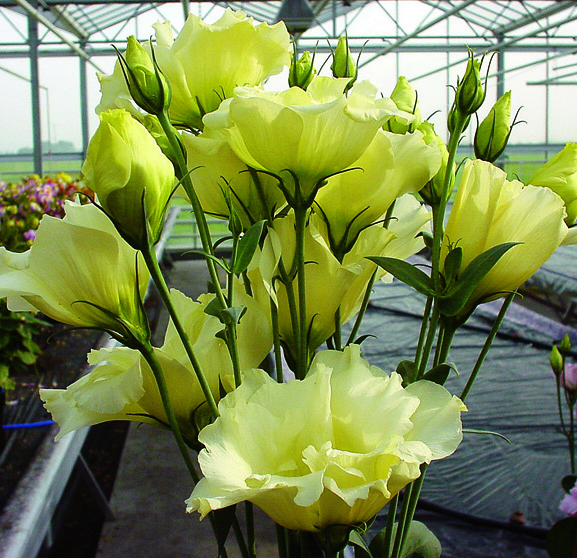
- Seedlings are planted by transshipment, with an earthen clod in pre-dug holes with warm water.
- A distance of 15-20 cm should be maintained between future bushes so that they grow freely.
- To adapt, seedlings are covered - usually with half a plastic bottle, a jar or a film on a frame. At this time, watering can not be done. When the flower gets stronger, the shelter is removed.
- For the development of the root system, the watering of the rooted plant is reduced, stimulating it to seek moisture in the soil;
- When the flower grows to 8-10 leaves, its top is plucked for better branching.
- During flowering, so that new buds form without interference, faded stems and peduncles are immediately removed. When the plant fades for the first time, it is pruned so that new branches appear and the eustoma blooms again.
- To support thin stems, they are tied to pegs or another supporting frame, such as a rope, is pulled.
reproduction
Eustoma has a fragile, fibrous root system. Reproduction by division almost always kills it. And planted cut cuttings take root with difficulty.
These flowers are usually propagated by seeds. They disperse beautifully and give boxes with small, excellent germinating seeds. When the plant has faded, the seeds can be collected and put in a dry place to dry out. They can be planted next year.
It is better to germinate seeds at home:
- Plants intended for the garden begin to be planted at the end of January - mid-February, so that the bushes have time to bloom in the summer - from mid-July. Indoor undersized eustomas are planted at any time of the year. The time between germination and flowering is approximately 5-6 months.
- Comfortable temperature is 20-21°C during the day and 15°C at night. Too high temperatures cause sockets to appear.
- Sow in a sterilized, well-drained substrate, with a low nitrogen content and a neutral acidity of 6-7. For example, a mixture of humus from bark, peat, washed sand or garden soil. Suitable mixtures for saintpaulias or violets, with the addition of a small amount wood ash.
- First, drainage is laid (for example, from expanded clay) with a layer of several centimeters and the container is filled with a substrate 2 cm below the edge.
- Seeds are scattered on the ground and lightly pressed down (but not buried), then cover with film or glass, leaving ventilation holes.
- Eustoma grows better in the light; with its lack, some of the buds may not grow or fall off. To grow a flower, choose a balcony on the light side of the apartment or special shelving with lighting or illuminated with fluorescent lamps. But you can not put it under the direct rays of the sun.
- The first shoots appear after 7-14 days. In order to avoid diseases, developmental disorders, they are sprayed with phytosporin, and for rapid growth - with zircon.
- Water them carefully so that water does not fall on the leaves - this can make them sick. It is better to spray instead of watering, and for the first few months, watering replaces the condensate from the film. The soil should not be too wet, but not dry either. Do not forget to remove excess condensate from the film. Water for irrigation should be separated - warm and soft.
- Eustoma loves clean, moist air, it must be ventilated and, if necessary, use humidifiers. She languishes in the dry, stagnant air;
- The flower is gradually "accustomed" to life without a film - once every few days, removing the film for 10 minutes, gradually increasing the time. After a few days - from three to a week, the film can be removed for the whole day.
- Shoots are protected from blackleg and other diseases by spraying with phytosporin from time to time.
- When the first leaves appear, the plants are carefully dived into pots with peat and charcoal about 5 cm in diameter at most - 3-5 seedlings. They dive very carefully, trying not to damage the roots. After transplantation, they are carefully protected from direct rays for several days.
- During growth, eustoma is fed once a week with a small amount of fertilizer with a calcium base and nitrogen.
- In mid-March, garden eustomas are transferred to large pots from 9 to 25 cm wide. Indoor flowers are transplanted into pots.
Coated seeds can be sown in peat tablets- they are placed in a small container, previously washed in potassium permanganate, and water is poured in small portions until the tablet swells. Then, using an awl, toothpick or other thin device, slightly press the seed into each tablet.
Sometimes the seeds are helped to sprout by waiting for their shell to get wet, carefully destroying it with a toothpick. In the process of growing sprouts, if the tablets begin to fall off, you will need to add a little water to the bottom of the container.
With this method of sowing the plant, its roots are not damaged during transplantation.
Eustoma care
1. Watering
Use warm and soft water. Eustoma does not tolerate excessive moisture, so it is watered after the top layer of the earth dries out.
2. Top dressing
Rooted seedlings are fed with soluble mineral fertilizers, in a smaller dose than prescribed in the instructions for the drug.
A month after planting, or immediately, in the case of sandy soil, they are fed with Plantafol. To improve growth, nitrogen-containing preparations are taken, for example, Plantafol Growth or Kemira diluted in water.
Before flowering at the end of summer, potassium and phosphorus-containing fertilizer "Plantafol Budding" is used to grow buds.
3. Diseases and pests
![]()
The main diseases that occur mainly due to waterlogging (improper care or rainy season):
- Gray rot- manifests itself in the form of gray spots and fungal formations on the leaves. Fungicides help against the disease, for example, Rovral, Euporen multi, as well as spraying with a Bordeaux mixture. Heavily damaged areas are removed.
- Fusarium- spots of rot protrude, the base of the stem darkens. This is a fungal disease that develops with excess moisture, lack of light. The diseased plant should be removed, and the soil carefully treated.
- powdery mildew- covers leaves and stems white coating the plant begins to wilt. Treat with several fungicidal preparations (Topsin, Saprol), but it is better to avoid the cause of the disease - high humidity.
Dangerous pests: aphids, whitefly, mushroom mosquitoes, spider mites, slugs. Symptoms: leaves turn yellow, sometimes covered with white spots, curl and fall off. Affected plants are treated with insecticides (Confidor, Mospilan, Fitovern, Aktalla, Aktellik).
4. Transplant
Eustoma roots are fragile and transplantation must be done very carefully, there is a high probability that the plant will not tolerate it.
Winter care features
Since eustoma is a heat-loving plant, it will not endure the cold season in the garden.
It can be carefully transplanted together with the soil into a pot and transferred to a cool (10-15 ° C) and bright room - then the bushes can be grown as perennials. During this period, water less often, do not feed, sometimes sprayed with "phytoverm" from pests.
Before wintering, the plant is pruned, leaving 2-3 internodes. In the spring, when the flower gives new shoots, it is returned to the ground.
Many gardeners, due to difficulties, prefer to sow eustoma again.
Answers to frequently asked questions
How can you avoid infection with diseases or pests?
In order to prevent diseases, the soil is disinfected by fumigation before planting or sprayed with Risolex after planting, followed by washing with water. The plants themselves are treated with fungicides, such as "Fundazol" or "Ridomir Gold"
The seeds are planted, but the eustoma does not sprout.
Perhaps the seeds were buried in the ground. This can not be done, they only need to be lightly sprinkled with earth.
I planted flowers in the garden, but they did not bloom.
You probably planted it at a high air temperature. In this case, it will bloom next year.
In general, eustoma is a rather complex, whimsical plant. Beginners are advised to start with indoor varieties. The main thing you need to know for its cultivation:
- Loves bright light, but does not tolerate direct sunlight.
- Eustoma comes from arid regions, so she does not need abundant watering, it harms her and causes fungal diseases, but drought should not be allowed.
- She needs mineral fertilizers in small doses.
- She prefers neutral soil acidity.
- Without access to air, the eustoma withers. Moist air is the most comfortable for her.
- Eustoma can only survive in light frosts.
- It takes patience to grow, as it grows slowly.
One of the brightest representatives of the plant world are eustoma flowers. By the way, the definition of "brightest" characterizes this plant literally due to its incredible color. This opinion is probably shared by all those who have this beauty at home in pots, where it is most often grown. Eustoma belongs to the gentian family. The flowers of the plant are very similar in appearance to rosebuds, so this plant is sometimes also called the "Irish rose", Lisianthus, or "Texas bluebell".
Translated from Greek"Eustoma" - "beautiful mouth" or in another interpretation "beautifully speaking".
But the name Lisianthus in Latin means "bitter flower". This phrase is quite appropriate, since eustoma contains various substances that were once used for medicinal purposes, and which give the flowers a bitter taste.
Historical data
The history of Lisianthus is very old, it dates back to the 19th century. The native side of eustoma is the southern countries North America. In 1806, the English botanist Richard Anthony Salisbury was the first to study this flower, giving it a name and classifying it. However, Japanese breeders achieved great achievements in the cultivation of the plant only in the 20th century, in the early 30s. After about 50-60 years, the "Irish rose" has reached world popularity and in terms of cultivation, it has surpassed many flower crops. It is best known in America, Australia and New Zealand.
There is a legend that a long time ago a young girl refused to be the wife of the spirit of war, which is why she died. It was on her grave that these flowers first appeared.
Description
Lisianthus is a perennial, but some gardeners grow it as an annual plant. In nature, there are a lot of different flower species that attract with their beauty. Some are unpretentious and do not require much effort to grow, but some are worth working hard to achieve the desired result. Eustoma is just that case. Most florists are mesmerizing and beckoning appearance flowers, respectively, they are interested in breeding and caring for them.
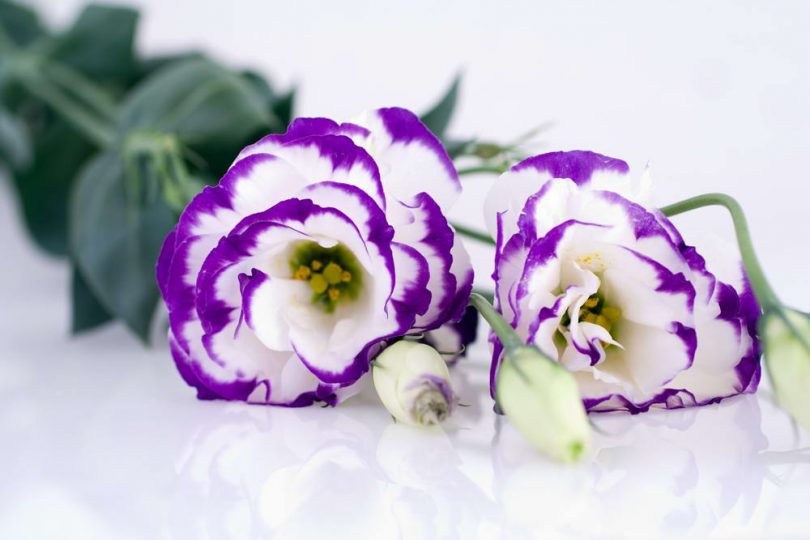 Lisianthus - simple and elegant
Lisianthus - simple and elegant The flowers of the plant are very reminiscent of unopened rosebuds. They are small in size from 5 cm in diameter, and are presented in a variety of color scheme: from light to dark colors, and there are even two-tone ones. They can also be simple or terry. Lisianthus petals seem very delicate and silky. The stem is thin and graceful, it has many flowers that open sequentially, although there are also varieties where flowering occurs simultaneously, forming beautiful bouquet. The leaves are distinguished by a semi-oval shape, with a wax coating, silver-gray or blue-green. To date, breeders have made great strides in creating new varieties where the stems reach a meter height, and the so-called potted varieties are no exception, their maximum height is about 30 cm. There are flowers that have an incredible aroma.
Growing eustoma: features
When breeding eustoma, it is important to consider many important factors.
This plant is a lover of bright diffused light, the best soil for it will be mixed peat with bark humus.
For those who liked this "beauty", it is important to remember that it reproduces only with the help of seeds, but watering is necessary when the soil is dry at least 2 cm deep. It is not recommended to transplant plants, because the roots are relatively weak, respectively, are not able to adapt to new conditions. best condition for the plant will not be a hot room with good air circulation.
Varieties and hybrids
At the moment there are more than 60 varieties of eustoma. Types of lisianthus are divided into undersized, which are good for indoor breeding and tall ones - for decorating the garden. The flowers of the plant can be double and simple and have a wide variety of colors.
Garden eustoma includes such species as:
- Aurora;
- echo;
- Heidi;
- Flamenko and others.
Indoor eustoma includes undersized varieties - Mermaid, little Bell, Florida pink, etc. Today, not only professionals, but also amateur florists can engage in its cultivation.
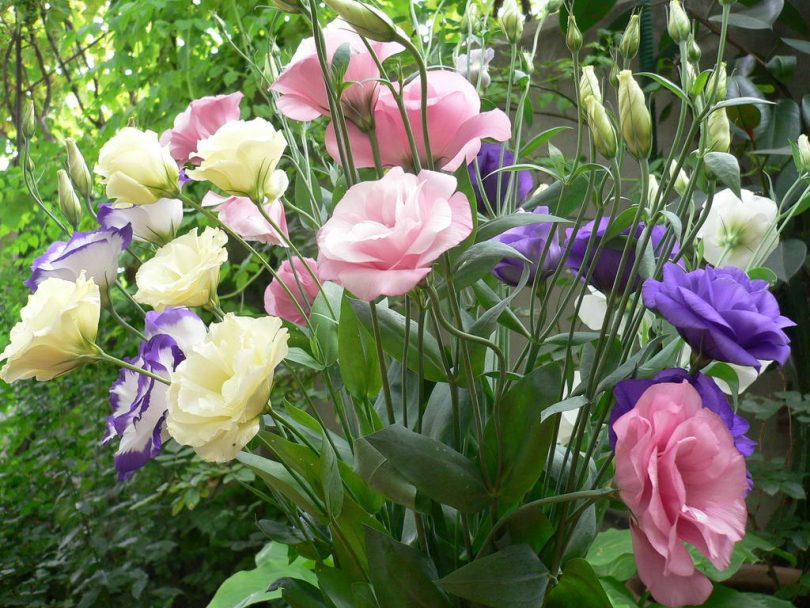 Lisianthus - a lover of bright light
Lisianthus - a lover of bright light Lisianthus from seed
Growing Lisianthus at home is a difficult task that requires a lot of time and effort, and perhaps patience. However, if you master all the subtleties of this process, the result can exceed all expectations. Due to the fact that the "Irish rose" is gaining great popularity among gardeners and amateur florists, growing and caring for it can bring considerable profit and satisfy an aesthetic need. The big problem is that eustoma seeds are quite small in size (1 g = 23,000 seeds), out of a hundred seeds sown, 60 will sprout.
 Growing eustoma on garden plot
Growing eustoma on garden plot If there is a desire to see the flowering of the "Irish rose" in the garden already in the middle of summer, then it is better to sow eustoma at the end of winter - beginning of spring. The soil should be sterilized and contain a small amount of nitrogen. Having scattered the seeds in the desired container, it is enough to lightly press them and cover them with polyethylene or glass on top so that there is free access to oxygen, additional light supply is desirable, it can be organized using fluorescent lamps 10-12 hours a day. The optimum air temperature should range from +14 ºC at night to +20 ºC during the day. The future plant will not need watering in the next 2 months due to the moisture received from evaporation, in the subsequent time, you can lightly spray the seeds. The results of the first shoots will be in a couple of weeks, after which it is necessary to remove the glass and regularly spray the seedlings with a solution of phytosporin. After the appearance of several pairs of the first leaves, you can immediately transplant them into larger containers. Three months later, future plants can be transplanted into open ground along with an earthen clod.
Indoor eustoma from seeds
In order for eustoma to be a wonderful decoration of the apartment in winter, it is necessary to sow it at the end of summer. To do this, you need to fill a small pot or other container with moistened soil, which includes sand and peat in equal proportions, and sprinkle seeds on top of it. Further, according to the same scheme: cover the top with polyethylene or glass for light penetration and place in a place where there will be a sufficient amount of heat and light. If necessary, spray and after three weeks the results will be obvious.
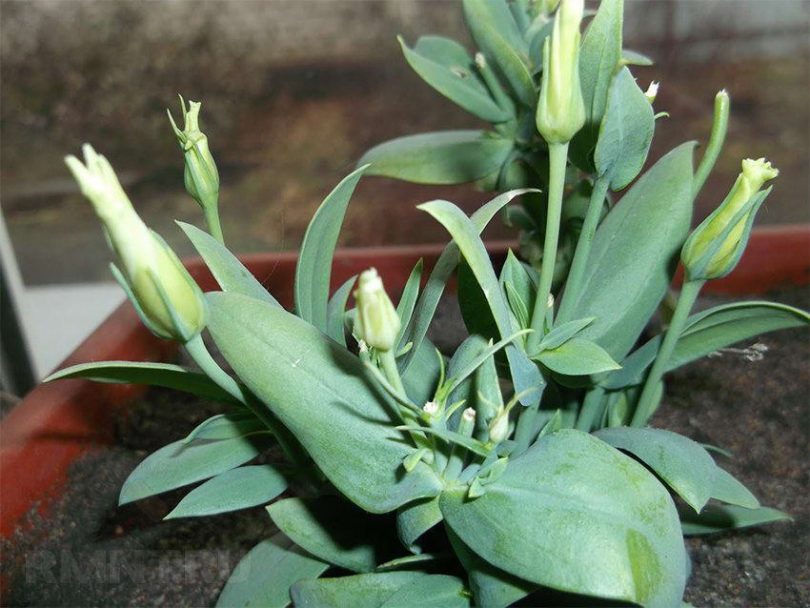 Growing at home
Growing at home Lisianthus seedling
When the first leaves appear, you can reduce the amount of moisture by allowing the topsoil to dry out a little. After that, it is worth watering, but it is worth doing it in the morning, so that by the evening the leaves remain dry. When the sprouts give two pairs of leaves, you can transplant into separate containers and wait for flowering, which will come in the middle of winter.
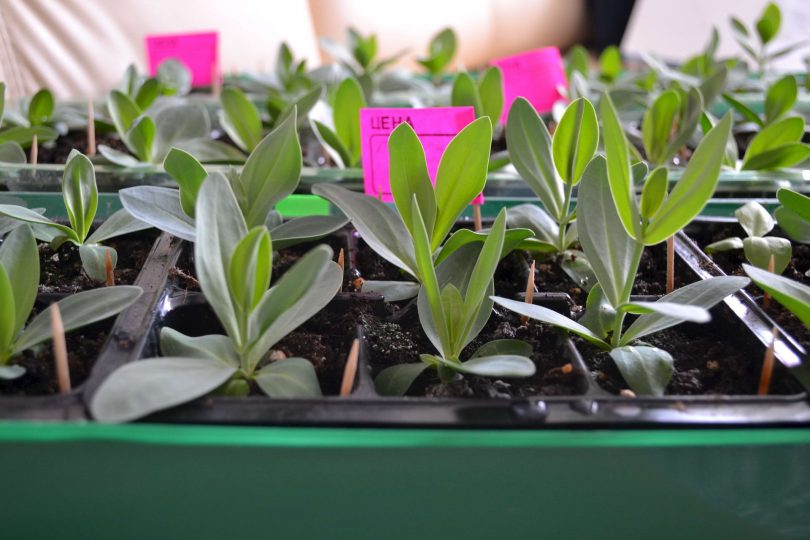 Eustoma seedling
Eustoma seedling Lisianthus Care
In order to grow this plant at home in a pot, it is important to remember that it should not be deficient in bright ambient light and oxygen. Therefore, it is worth choosing a place where it would be possible to maintain the desired temperature and have access to constant ventilation, for example, a window to the west or east. When watering, it is important to remember the "golden mean" so as not to overdo it in waterlogging or deep drying, although a slight drying of the top layer is quite appropriate. Water for irrigation should be settled and soft. It is not necessary to spray the plant to avoid leaf disease, but it is worth fertilizing during intensive growth and bud formation.
Compliance with the necessary conditions is the key to re-blooming.
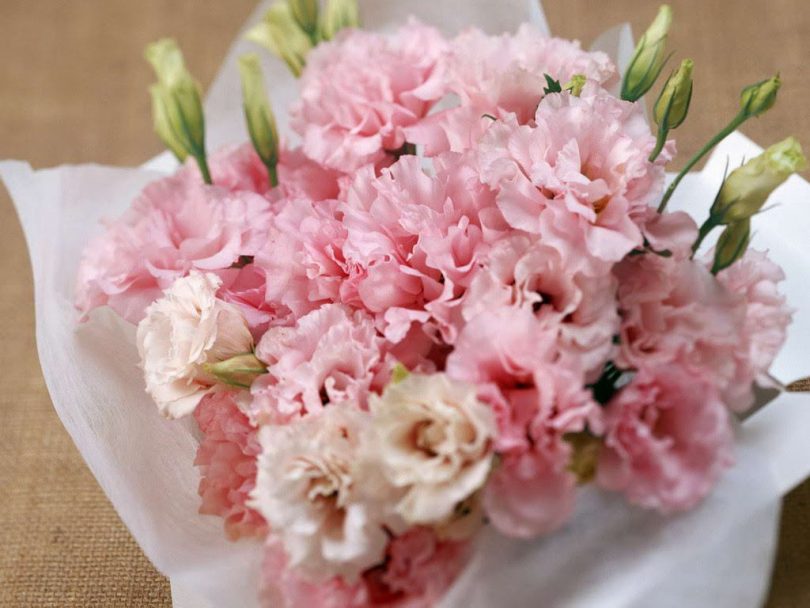
Growing eustoma garden
Eustoma for the garden is grown from seeds, sowing at the beginning of winter (December, January) so that the flower blooms by summer. For sowing, you can use small cups and soil, as for violets. Seeds are laid out on top, 5 pieces each and covered with a film, creating the effect of a greenhouse. Every time, with a frequency of ten days, it is necessary to lift the cover to allow fresh air to enter and remove excess moisture resulting from evaporation. It is important to remember the mandatory conditions - the optimum temperature is not lower than +20 degrees and a sufficient amount of daylight. At the end of winter, the seedlings can be placed on the windowsill so that they soak up the rays of the almost spring sun.
Garden eustoma can also be grown using seedlings. This should be done in the month of May, when the likelihood of frost is minimal.
The chosen location assumes the presence of good diffused light and protection from drafts. It is better to plant in the evening or when it is cloudy outside, in a small hole, pre-moistened. The seedling is put into the hole along with the soil in which it grew. The distance between the units is 10-15 cm. After planting, you can cover the seedlings with glass jars and do not water, moisture will be due to condensate. If at least 6 leaves appear on the stem, it is recommended to pinch the top so that the young plant branches better.
How to grow eustoma at home (video)
Eustoma after flowering
If this is an indoor eustoma, then after flowering it needs to cut the stem so that 2-3 internodes remain. During the dormant period, it can be stored in a room where the temperature is about 15 degrees above zero, it needs to be watered very rarely, there is no need to feed at all. When new shoots appear, the plant is transplanted into a new substrate and normal care is resumed.
If we are talking about garden lisianthus, then its flowering can be extended by transplanting into a pot and relocating to the territory of a balcony or window sill. At home, the flower will be able to exist for some time, but the state of rest is no exception for him. During this period, caring for a plant is no different from caring for room eustoma.




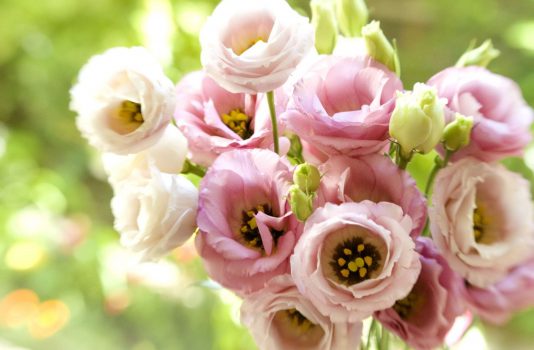
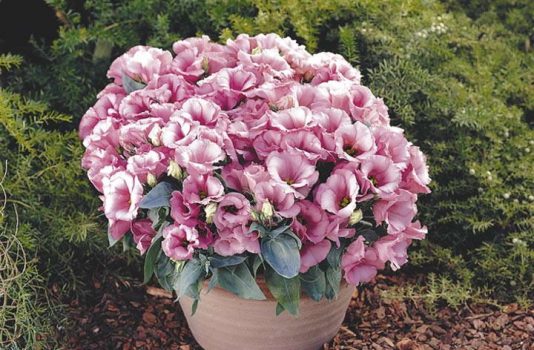
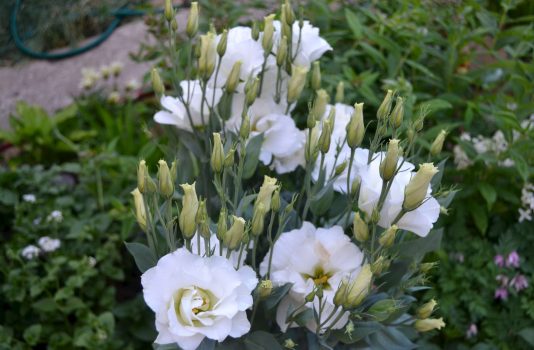
Eustoma - growing from seeds, planting and care. Eustoma (lat. Eustoma), also called lisianthus (lat. Lisianthus - bitter flower), or "Irish rose", or "Texas bell", or "Japanese rose", belongs to the gentian family. Translated from Latin, "eustoma" literally means "beautiful mouth", and in a more literary version - "beautifully speaking". The homeland of eustoma is considered the south of North America, Mexico, the north South America and Caribbean islands. The legend of the American Indians tells that for the first time eustoma bloomed on the grave of an innocent girl who was mortified by the spirit of war because she refused to become his wife. The Irish doctor and botanist Patrick Brown discovered eustoma for Europeans. The plant is very popular among flower growers as a cut flower, as a freshly cut eustoma can stand in a vase of water for up to three weeks. It has been cultivated as a houseplant since the nineties of the last century. We offer a wide range of Eustom (Lizanius) seeds in our store. www.seeds.net , http://www.xn--80aja1agu.net/ru/8-flower-seeds
Eustoma flower - description The stems of eustoma are strong, almost a meter high, but graceful, like a carnation. From the middle, the stems begin to branch, so the branch is a whole bouquet, in which there can be up to 35 buds that bloom alternately. Eustoma leaves have a grayish or bluish tint, they are lanceolate-oval, matte, as if made of wax. The calyx is funnel-shaped, large and deep. Eustoma flowers, double and non-double, 5-8 cm in diameter, different shades - pink, purple, white, purple, plain or with a contrasting border. When the eustoma bud is half open, it looks like a rose, when the flower opens, it resembles a double poppy. Eustoma is a biennial plant in nature, in the garden version it is usually grown as an annual. Perennial eustoma is possible only in a pot version. In the ground, eustoma can be grown as an annual and biennial plant. Features of growing eustoma - eustoma prefers bright diffused light; - the best soil for eustoma - humus from the bark and peat in equal proportions; - propagated only by seeds, since the cuttings do not germinate, and the too fragile root system does not tolerate division; - you need to water only after the substrate has dried 2 cm deep; - try not to replant the plant: it is perennial only conditionally, and the roots of the transplant will not be transferred; - home eustoma blooms best in a ventilated cool room.
Types and varieties of eustoma Although there are about 60 species of eustoma in nature, only varieties of Russell's eustoma (Eustoma Russelianus) are grown as a pot culture, and varieties of large-flowered eustoma (Eustoma Grandiflorum) as a garden crop. Some flower growers even believe that this is the same species, and while flower growers find out who is right, we will separate the types and varieties of eustoma according to their intended purpose. Eustoma is undersized (not higher than 45 cm) or high. high grades grown in the garden for cutting, and undersized - mainly as room or balcony. Tall garden eustoma for cutting: - Aurora variety: terry eustoma, height 90-120 cm, flowers in blue, white, light blue and pink. Flowering early, 2-3 weeks earlier than other varieties; – variety “Echo”: height 70 cm, spreading stems, large flowers, early flowering, 11 color variations, both monochromatic and two-color; - variety "Heidi": plant height 90 cm, simple flowers, abundant flowering, 15 color variations in the culture; - variety "Flamenco": height 90-120 cm, strong stems, flowers are simple, but very large (up to 8 cm), the main advantage is not capricious. Lots of color variations.
Low-growing varieties of eustoma for growing in an apartment: "Mermaid": height is only 12-15 cm, flowers are simple, up to 6 cm in diameter, shades of white, blue, pink and purple. Does not need pinching to enhance branching; - "LittleBell": does not exceed 15 cm in height, the flowers are simple, medium-sized, funnel-shaped, of different shades, does not need to be pinched; - "Loyalty": white eustoma with multiple simple flowers arranged in a spiral on the peduncle, height up to 20 cm; - "Florida Pink": pink eustoma with simple flowers that form an even bouquet. Growing eustoma from seeds Growing eustoma at home is a painstaking and time-consuming task. However, for those who master this process, it can become a very profitable business, as eustoma becomes more and more popular and how garden flower, and as a pot culture. This section will discuss how to grow eustoma from seeds, and the main difficulty in this process is that eustoma seeds are too small: there are 23,000 of them in one gram! Purchased seeds undergo a special treatment to increase germination, therefore, out of a hundred of these seeds, about sixty sprout.
If eustoma from seeds is grown for planting in the garden, then it should be sown in February or March, then it will bloom in July-August. The substrate is needed, as for flowering plants: sterilized, low in nitrogen, pH 6-7. After scattering the seeds, do not cover them with soil, just press lightly and cover the container with film or glass, leaving gaps for air circulation and arranging additional illumination with fluorescent lamps for 10-12 hours a day. The temperature for seed germination should be at least +20ºС during the day and at least +14ºС at night. Instead of watering, spray the seeds from time to time, although for the first two months you are unlikely to have to do this: there will be an excess of evaporated moisture. If all conditions are met, seedlings should appear no later than two weeks later, and as soon as this has happened, you need to remove the cover and periodically spray the seedlings with a phytosporin solution. As soon as the seedlings have several pairs of leaves (this will happen in about a month and a half), dive them into pots with a diameter of 4-5 cm. After three months, the plant, together with an earthen clod, is planted in the ground.
Eustoma at home Planting eustoma. If you want to decorate an apartment with blooming eustoma in winter, sow from July to September. Fill a small container with a wet substrate of sand and peat (1:1) and scatter the seeds over it. Place the container covered with film or glass in a warm (19-22ºС) and bright place, spray the seeds if necessary, and in two to three weeks you will wait for shoots.
As soon as the seedlings have the first pair of leaves, the amount of moisture is reduced, allowing the topsoil to dry out between waterings. In the future, moisturize only in the morning, so that, in order to avoid the “black leg” disease, the leaves are already dry in the evening and at night. When the sprouts have two pairs of leaves, you can dive them into separate pots and wait for flowering, which should come in January-February.
Eustoma care at home. Growing eustoma in pots is not an easy task, because it is in dire need of fresh air and bright diffused light. The best way out is a western or eastern window in the room with the ability to maintain the optimum temperature for the plant at 19-22ºС with regular ventilation. In addition, caring for eustoma involves moderate watering with settled soft water as the topsoil dries up. Try to avoid both waterlogging the soil and its drying out. It is not necessary to spray the plant, as this can lead to leaf diseases. During the period of intensive growth and during the formation of buds, eustoma should be fed with liquid complex fertilizers in the consistency of 10-15 ml per 10 liters of water. And, of course, wilted flowers must be removed in time. Try to comply with these conditions, and your eustoma will delight you with its flowering again in 90-100 days. Eustoma in the garden - planting and care How to grow eustoma. Garden eustoma can be grown from seed, sown in December or January to bloom in June or July. Fifty-milliliter cups are filled with soil mixture for violets and 3-5 seeds are laid out on top, slightly pressing them into the ground, and covered with a film so that the eustoma grows like in a greenhouse. The film will have to be lifted every 10 days to remove condensate from it and allow the seedlings to breathe a little. The optimum temperature for germination in two weeks is 20-25ºС. The first couple of months, seedlings also need additional illumination, but even with all these necessary conditions, seedlings will grow very slowly. At the end of February, seedlings are placed on a sunny windowsill.
Planting eustoma for seedlings. As a preventative measure, spray the seedlings with a solution of foundationol at the rate of 1 teaspoon per 1 liter of water, and for faster growth - with zircon or epin. A month and a half after the emergence of seedlings, when they already have a couple of leaves, dive the seedlings into pots of 3-5 pieces, immersing the lower leaves in the ground. Don't forget to water and cover each pot with a plastic bag for a greenhouse effect. In a week, the seedlings will double in size. In late February or early March, transplant the seedlings into larger pots (diameter 8 cm) along with an earthen clod by transshipment, after placing a drainage layer in the pots. Now they will grow up, waiting for landing in the ground.
Growing eustoma in the garden. In mid-May, when the risk of frost is over, the seedlings are planted in open ground. A place for eustoma is chosen protected from drafts, with good drainage, light, but the light should be diffused. Landing is carried out in the evening or in cloudy weather. A seedling is immersed in a well-moistened hole along with a clod of earth in which it grew in a pot. Eustoma grows in a bush, so it should be planted at a distance of 10-15 cm from each other. After planting, cover the seedlings for the first 2-3 weeks with glass jars or cut plastic bottles, during which time you do not need to water them. We have already written about watering, we will only clarify once again: eustoma is harmed by both increased soil moisture and lack of moisture. When 6-8 leaves are formed on the stalk, pinch the top so that the plant branches better. About a month after planting, when the seedlings are already well rooted, they need to be fed with soluble mineral fertilizers. Plantafol is suitable for this purpose. In June, spray the eustoma with the Plantafol Growth preparation with a high nitrogen content, and in July and August with the Plantafol Budding solution. You can use the drug "Kemira", it is dissolved in water and the plants are watered under the root. Just try to use drugs in a slightly lower concentration than the manufacturers suggest. The start of flowering of eustoma depends on when you sowed the seeds. If the sowing took place in late November or early December, then the eustoma will begin to bloom in early or mid-July - it also depends on what kind of spring it will be. If you sowed the seeds in mid-January, then flowering will most likely begin in August. After the beginning of flowering, this process does not stop until the end of October: some buds fade, others bloom, and so on. Blooming eustoma and early frosts do not frighten, and only with a frost of -10ºС and snowfall can eustoma bloom stop. If your eustoma has faded early, cut off the wilted flowers, and, quite possibly, the eustoma will bloom again in six weeks.
Among the pests of eustoma, aphids, slugs, whiteflies and spider mites are dangerous. To protect against insects, actara, fitoverm, actellik or confidor should be used. Powdery mildew, fusarium or gray rot, from which it can be saved by preventive spraying with foundationazole or the use of the drug "Ridomir Gold". Eustoma after flowering Domestic eustoma. In a faded potted eustoma, the stems are cut so that 2-3 internodes remain on them, and they are transferred to storage in a room with a temperature of + 10-15ºС. Watering during the dormant period is rare, it is not necessary to feed the plant. In the spring, when you see new shoots, transplant it carefully, along with an earthy clod, into a new soil and resume watering and regular care.
Garden eustoma. You can extend the flowering time of your garden eustoma by transplanting it, along with garden soil, into a pot and moving it to a balcony or windowsill. In the house, for some time, with normal care, she will delight you with flowering. But a dormant period occurs in all plants. After the flowers wither and the leaves turn yellow, the garden eustoma is treated in the same way as with the room one: the stem is cut at a height of 2-3 internodes and transferred to a cool, well-ventilated room, almost stopping watering. There she will wait for spring. These ten tips will help in growing and caring for eustoma. 1. Buy seeds of eustoma (lisanthus) marked F1 - these are hybrids that can withstand temperatures of t = 15-18 ° C during germination and growth, and also require less light and bloom faster. 2. Eustoma, due to the long growth of the root system, is recommended to be planted in February, or even earlier with obligatory highlighting. But it should be remembered that the flower is very sensitive to light, so seeds planted at the end of March can easily catch up with those planted in February: this is how eustoma reacts to an increase in daylight hours. 3. If it seems that the seedlings seem to be frozen and not moving in growth, feed them by spraying with a solution of HB-101 or Zircon - these preparations help the flowers both in growing roots and in growth, strengthening their immunity. You can alternate preparations HB-101 and Zircon with fertilizing with Kemira-Lux fertilizer. 4. While the eustoma is small, it can be watered from a syringe or pipette according to the following scheme: Fill a 10 ml syringe with room temperature water, pour it into about 2 peat tablets. Do not let the tablets float in water or dry out. After the cotyledon leaves of the lisanthus straighten out, you can add the HB-101 or Zircon preparation to the water (1-2 drops per 1 liter of water). 5. For growing and planting eustoma in the garden, choose the eastern side of the window or garden. If, during the growth of seedlings, the air temperature exceeds + 25 ° C, then lisanthus can only grow rosettes (like, for example, cabbage) and not give the main flower stalk; in this case, its flowering will be much later or not at all. 6. Eustoma is such an elegant and delicate plant that it can suffer from rain and lose its decorative effect, therefore experienced flower growers recommend growing eustoma under a canopy - in gazebos and recreation areas - or in greenhouses, greenhouses; in containers, flowerpots, which can be transferred from bad weather to shelter. 7. It is better to cut the lisanius for a bouquet over the second pair of leaves (from the ground); flowers should be open 1 ½ - 2 ½. Tall lisanthus bushes are best tied to supports or grown in a bush holder. 8. If the eustoma bloomed in early summer (this happens during early winter planting), then after flowering, cut the stems with wilted buds without touching the rosette of leaves. In this case, the eustoma will bloom again in one and a half to two months. 9. In some gardens, under favorable conditions, eustoma can behave like a biennial. That is, planting it with seeds in the spring, in the summer you can only observe the growth of a rosette of leaves, and flowering occurs next season from the beginning of summer. 10. With all the difficulties in growing eustoma, this flower is very strong and practically resistant to diseases and pests. Eustoma leaves are bitter in taste, so caterpillars and bugs do not like them. If the lizaetus has ascended, then it will surely survive if three basic conditions are met: top dressing once every 10 days, light and heat for the roots - the pot should be on a warm windowsill or in a foam tray. Note. With a very early planting - December, January - lisanthus can bloom on your windowsill at home. If this happens, then it is better to remove the buds, pinch; it is necessary that the flower grow as many roots and green mass as possible, only then its flowering in the garden will be long and lush. We offer a wide range of Eustom (Lizanius) seeds in our store
Luxurious meadow with eustoma
Planting and caring for eustoma is not easy, but the result of these works is worth the effort. Graceful thin stems adorn lanceolate-oval leaves of a green or bluish hue. Beautiful terry and semi-double buds, which, when closed, resemble rose, and in the open - fluffy poppies, can have a variety of colors. It can be shades of blue and lilac, white, salmon, yellow, pink and so on.
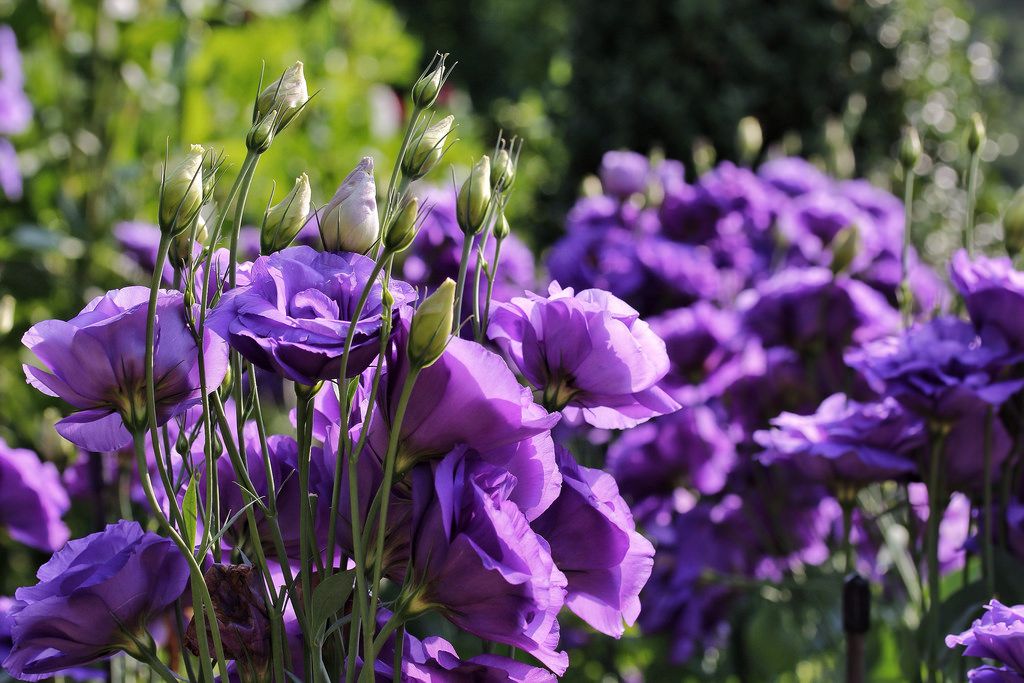
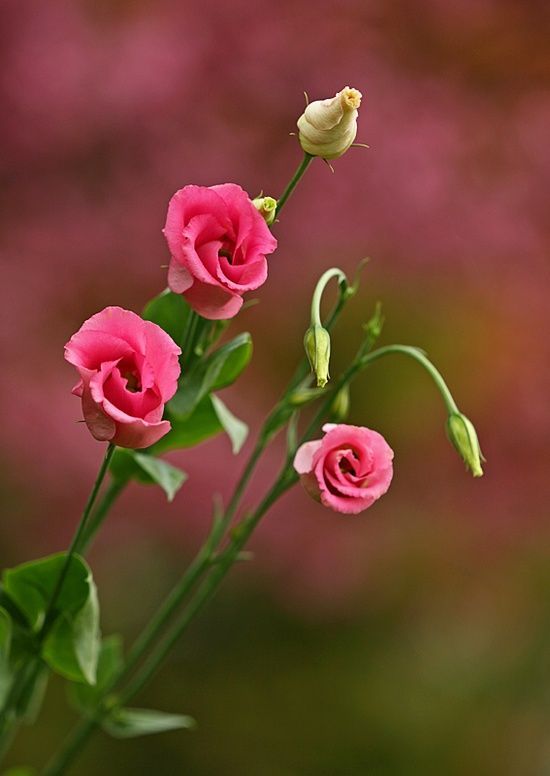
The birthplace of the eustoma flower is in the southern states of the United States of Central America. The plant also feels comfortable in the Caribbean. All these territories are united by a humid and warm climate, and therefore it is important to be able to create similar conditions for growing eustoma.
Recently, lisianthus (as this plant is also called) is grown especially actively both for the gardeners' own pleasure and for sale.
Idea! Bouquet of eustoma- an excellent decoration of the house, which will perfectly fit into the interior and give it a touch of tenderness and sophistication. If you change the water to fresh water in a timely manner, cut flowers will last up to three weeks.

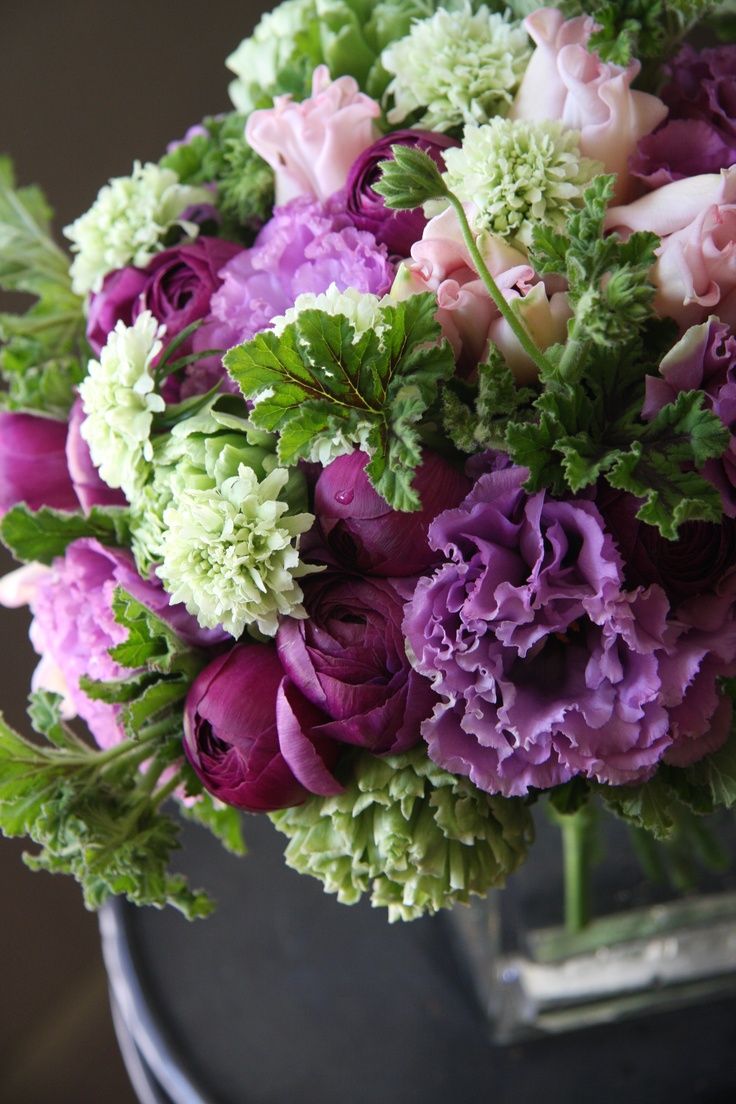

Species and varieties
Breeders have done a good job of breeding new species and varieties of large-flowered eustoma. To date, there are many varieties of this plant, the most famous of which are:
- Flamenco. Relatively unpretentious variety. It grows up to 120 cm high, has large buds, up to 8 cm in size.
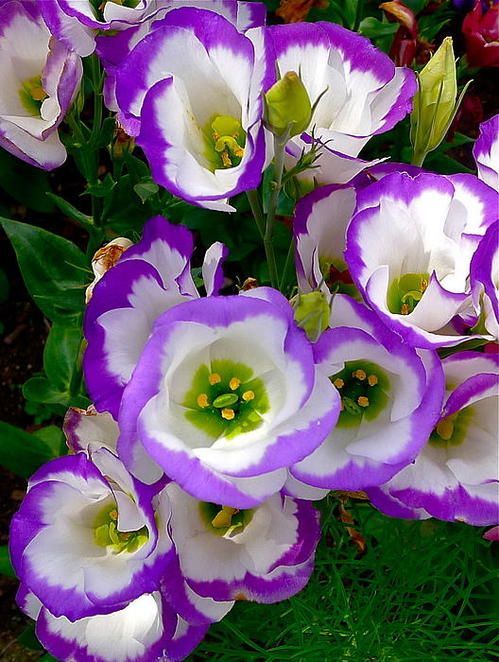
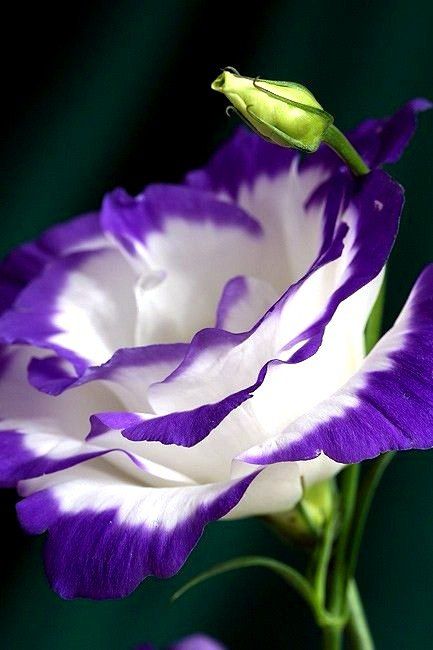
- Aurora. Tall plant (up to 120 cm) with double flowers. If you want to get early flowers, plant Aurora, as its flowering period comes earlier than other varieties.
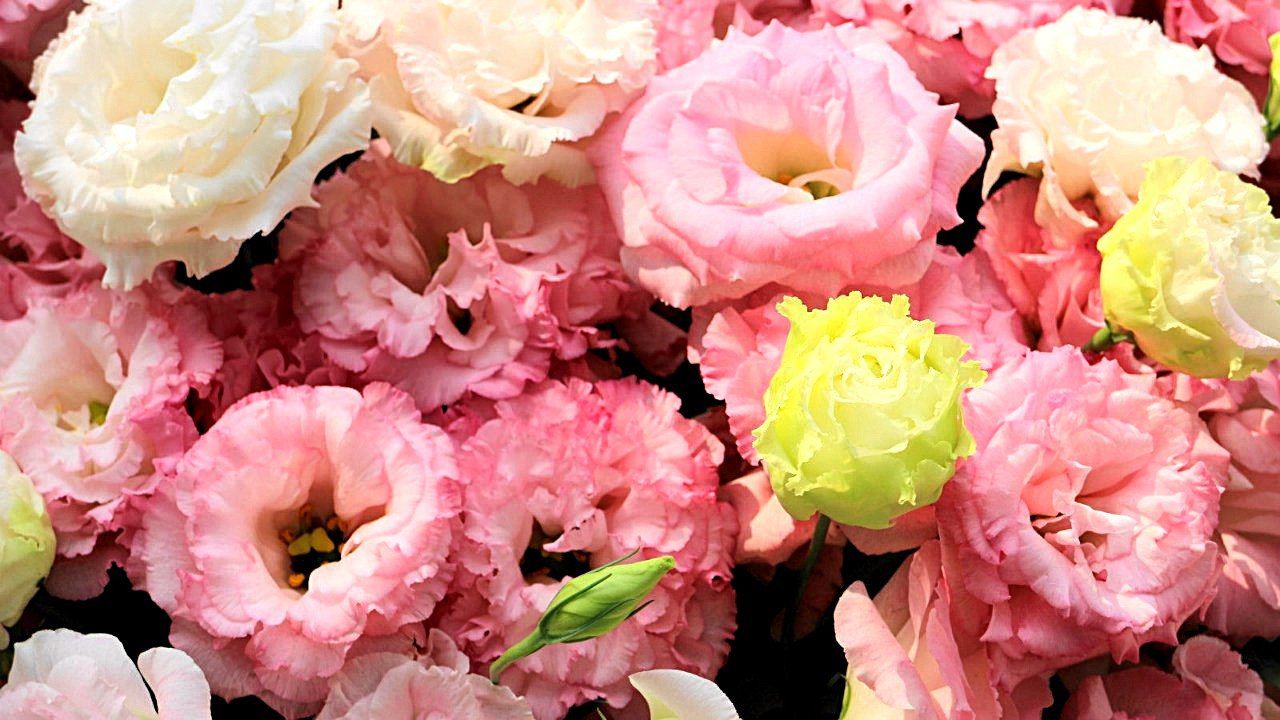

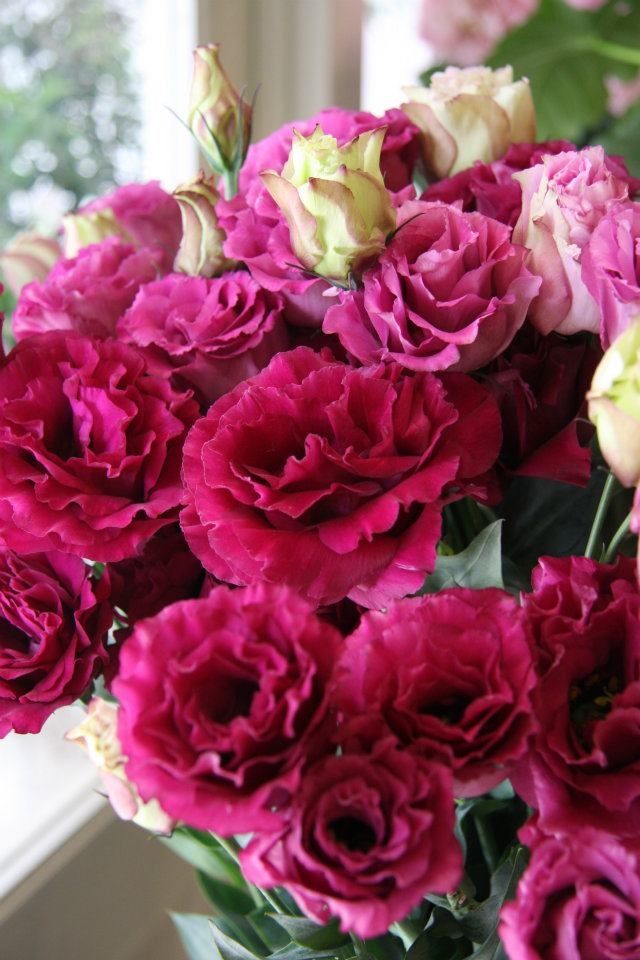
- Loyalty. Dwarf variety (height - up to 20 cm), the flowers of which are arranged in a spiral.

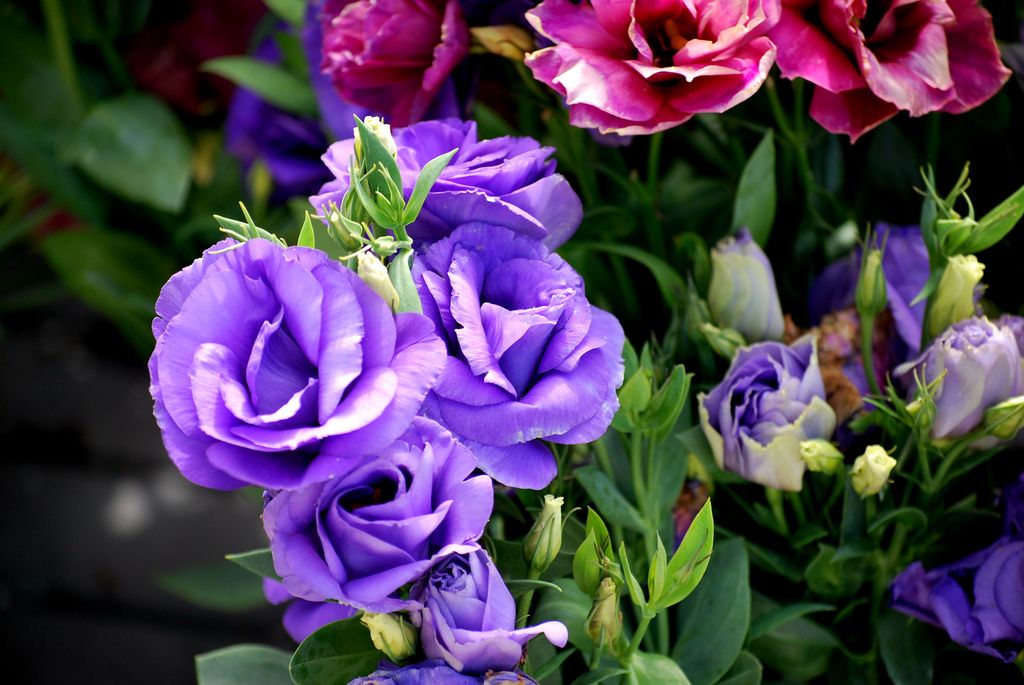
- Heidi. This type of eustoma is characterized by abundant flowering and an average height of up to 90 cm.

How to grow eustoma in the garden and at home?
This plant can decorate both the garden lawn and the interior of your home. Keep in mind that in garden conditions it is usually annual, while in a pot it can live for several years.
Remember! Eustoma - perennial, but her roots are unusually fragile, and therefore you should not have high hopes for transplanting and dividing the root system, since the flower simply may not survive this.

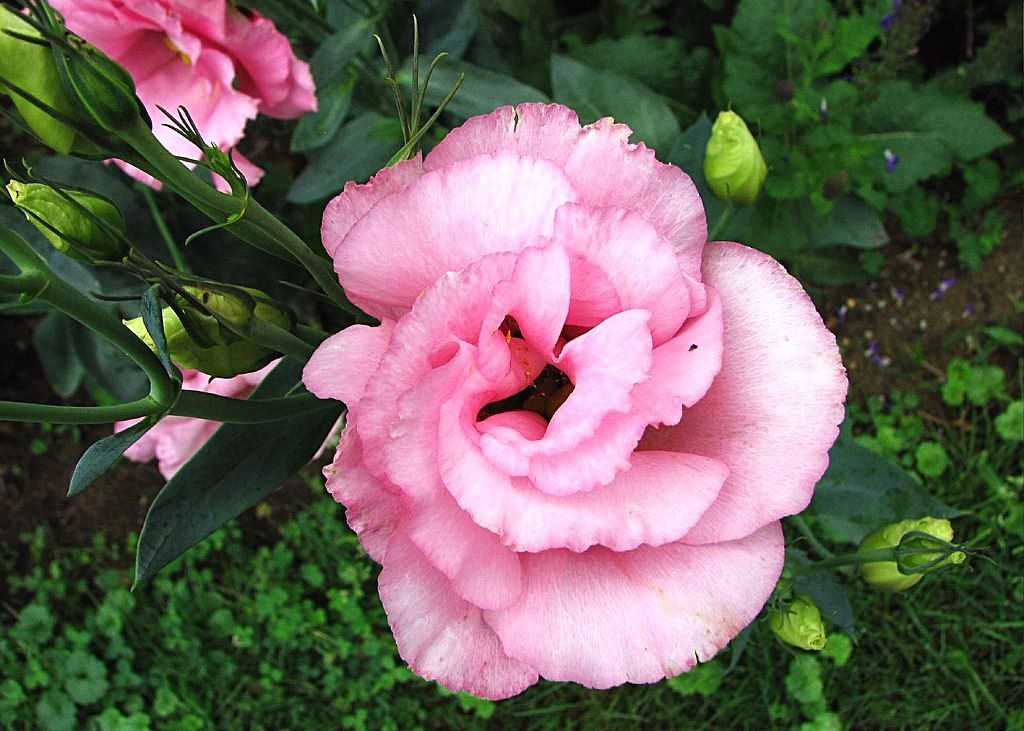
Growing eustoma from seeds
Growing Lisianthus (this is the second name for eustoma) is possible from seeds. You can, of course, take a chance and try to divide its root system, but the likelihood that the idea will be unsuccessful is very high. Rooting cut cuttings also often fails. Therefore, the most win-win option is to use seeds for planting eustoma. After flowering, the plant brings a rich harvest, consisting in small boxes. Usually one gram contains up to two thousand seeds, which, by the way, have a very high level germination.
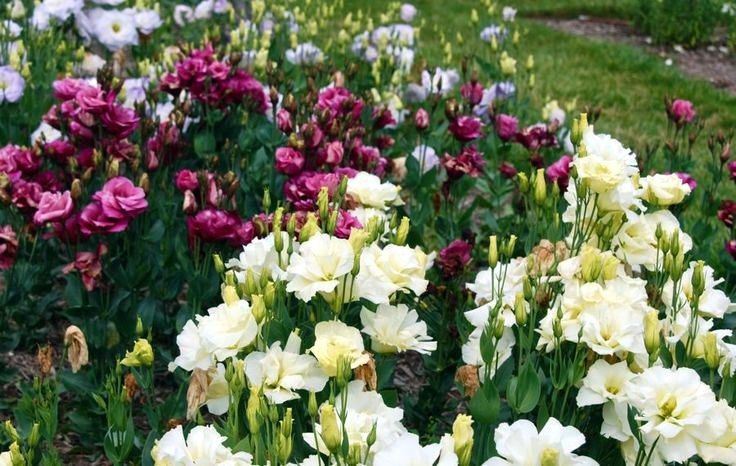

To sow the Irish rose (also called Lisianthus) by seed, it is necessary to prepare the soil. For this, a sterilized purchased substrate is suitable, which has low nitrogen content and a pH of no higher than 6-7. Seeds do not need to be immersed in the ground: just scatter them in an even layer on the surface of the substrate and press a little, after which you will need to cover them with a film to create a greenhouse effect. It will not be superfluous to install above the container with seeds daylight lamps(for example, a special lamp “Flora” is suitable).
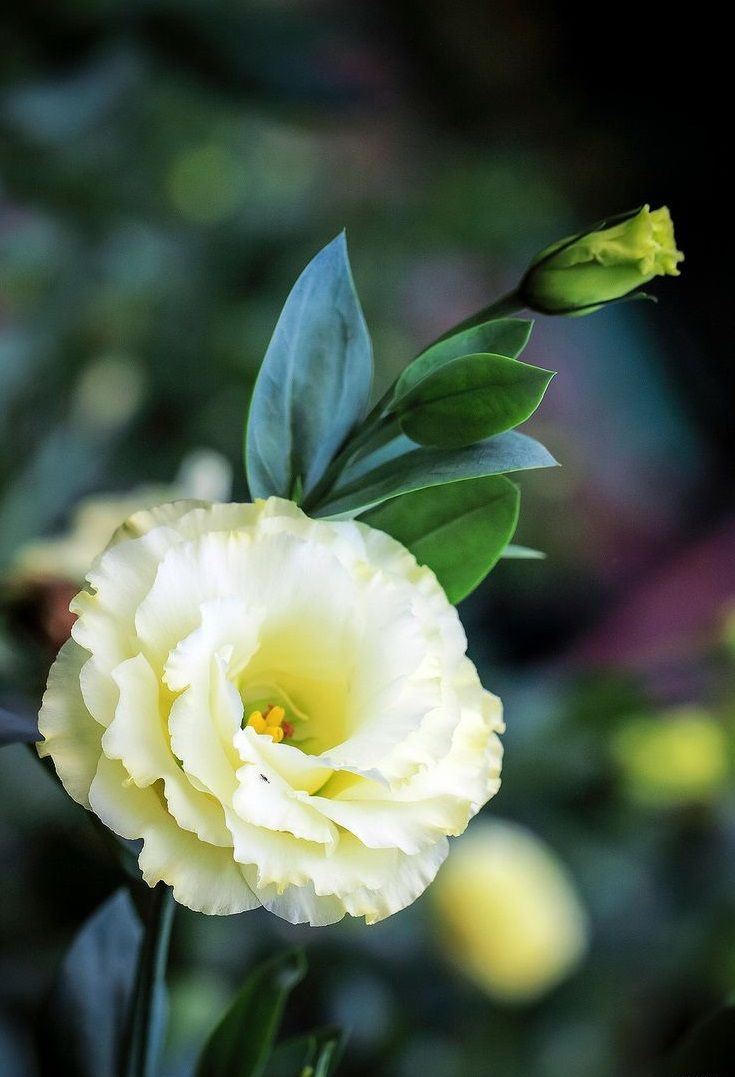
As for watering the seeds, the substrate should always remain slightly moist. You can spray it from a spray bottle, but at first the moisture evaporated due to the presence of the film should be quite enough.
The optimum temperature for good development Irish rose seed is 20 degrees in daytime and 14-15 at night.
Remember! The time of sowing eustoma seeds is related to when you plan to get flowers. So, for example, if a gardener wants his plot to be decorated with flowering lisianthus in July-August, then it should be planted in February - early March. If you need to get a homemade eustoma that will bloom in winter, sowing time falls in July, August and September.


Such a strict time frame is due to the fact that the first buds will appear only four to five months after the growth appears.
When the first shoots are tied, the film must be removed. At this time, it is possible to carry out preventive treatment of young shoots with a solution of phytosporin. After the appearance of the first pair of leaves, you need to dive plants. To do this, you will need shallow pots or plastic cups up to 50 ml. Transplantation into the ground occurs after three months by transshipment along with an earthen clod. It is recommended to do this in mid-May to avoid possible frosts.
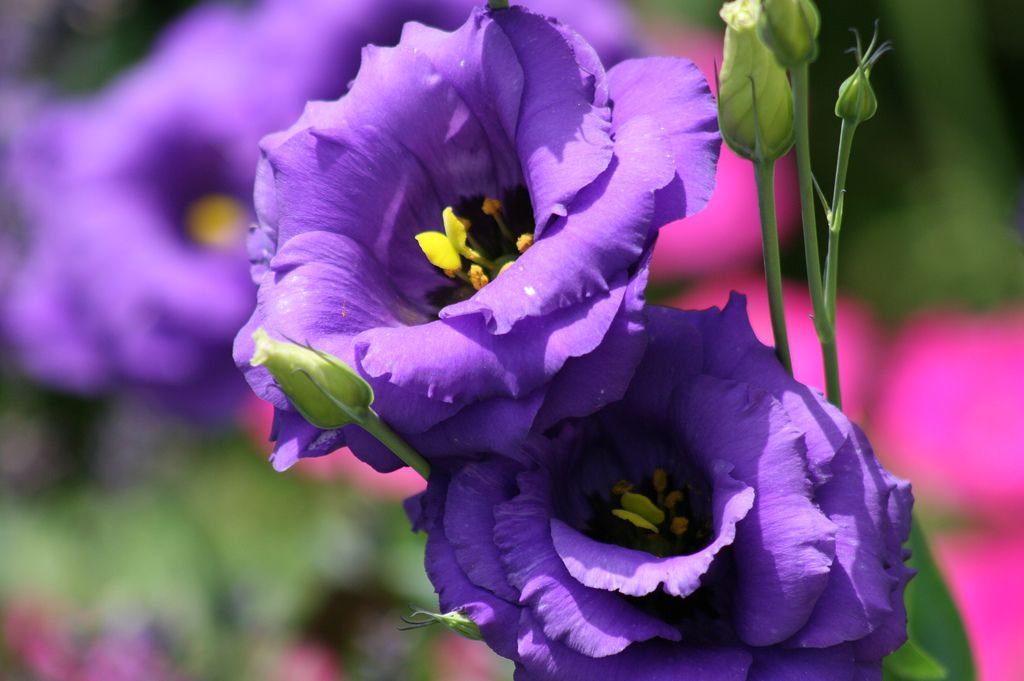
Eustoma at home
If you want to grow this plant at home, follow all the recommendations described above. The difference lies in what follows the pick. When you dive Lisianthus, place the seedlings in pots, line the bottom with a drainage layer. As a soil, a mixture consisting of equal parts of garden soil, humus, coarse sand taken in equal parts is suitable.
Advice! To improve the growth conditions of eustoma, you can add a little wood ash and lime. It is also recommended to slightly loosen the topsoil from time to time.
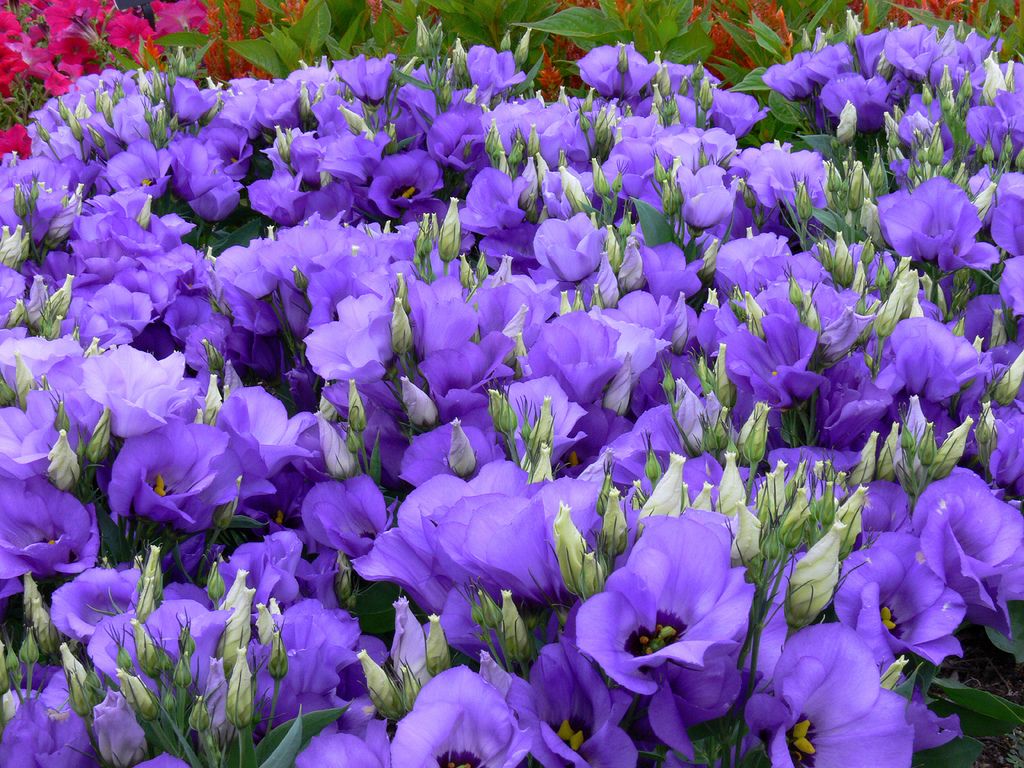
Luxurious "carpet" of eustoma in the garden

Watering
Watering the plant is advised as the top layer of the earth dries. An exception is the period of seed ripening in the soil under the film: at this time, the substrate must always remain moist both inside and on the surface. When grown flowers are planted in a pot or open ground, it is enough to water them when the top layer dries by about 1-2 cm. During the rest period, watering should be slightly reduced, while during flowering it should be more plentiful.
Advice! Water the eustoma only on top of the pot. It is not recommended to pour water into the pan.
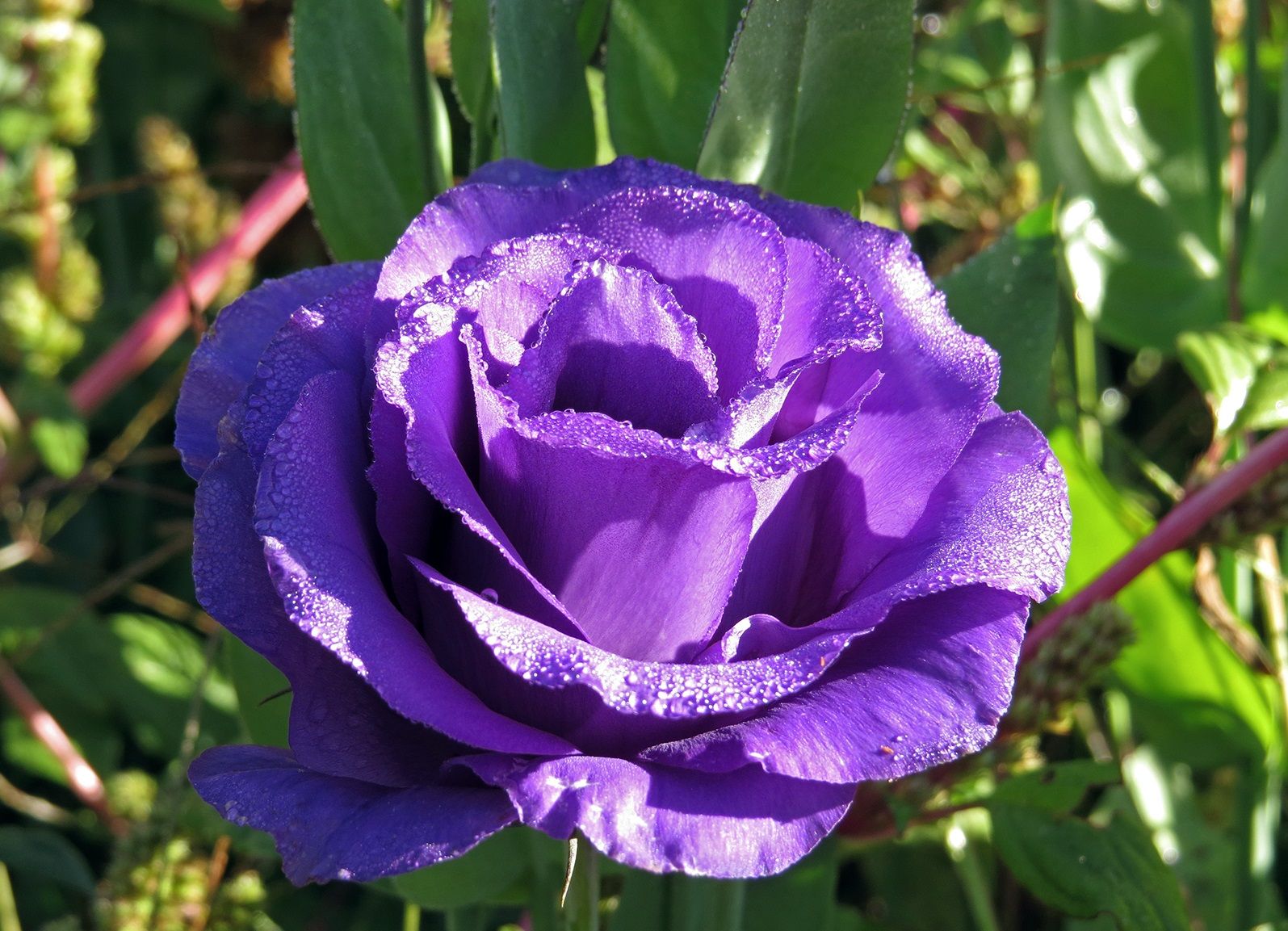
Eustoma joyfully opens the bud after "bathing"
Lighting
Best of all, the Irish rose feels in bright diffused light. It is recommended to plant it on the east or west side of the house, and at home put it on windows facing the indicated cardinal directions.
Keep in mind that during the rest period, this plant is able to put up with a lack of light, while during active growth it is better to prevent this.

Temperature
During growth, the temperature in the room should be about 20-25 degrees, but during the dormant period, the plant should be moved to a cooler place where the temperature would not be higher than 10-15 degrees.
Better than eustoma can only be many, many chic eustoma
Advice! For top dressing, use fertilizers at a lower dosage than indicated on the package.
pruning
Usually this procedure occurs after flowering. It is necessary to cut the stems so as to save 2-3 internodes. You can also pinch: for this, after the first 6-8 leaves appear on the stem, you need to pinch its top. This will create conditions for the eustoma to give more branches.
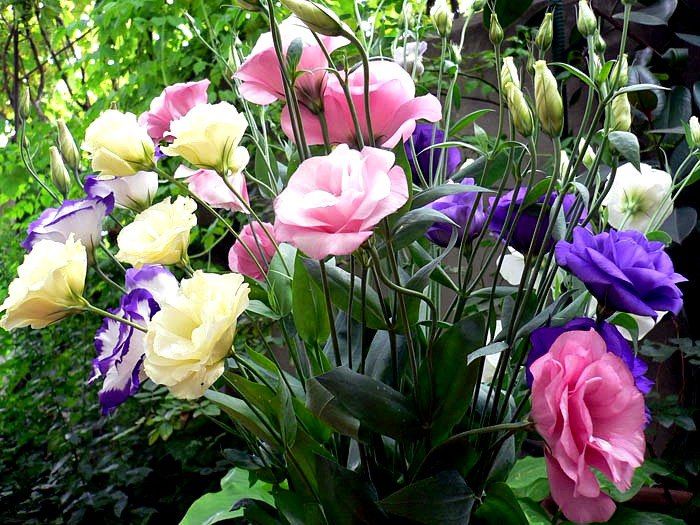
Perennial eustoma is a beautiful flower, which so far can be found more often in a bouquet than in a garden or in a house. They call it an Irish, Chinese, French, Japanese or Mexican rose, because not fully opened buds really resemble a rose. You can also find the name "Texas bluebell", as it comes from Mexico and the southern states of the United States. It was from there that this plant was brought to Ireland, where it took root well and caught the eye of Japanese breeders, who bred about 50 garden, greenhouse indoor varieties with different colors.
The biological name of the original for all popular varieties of the species is large-flowered eustoma, it is Russell's Lisianthus. The leaves of this plant are bluish-green, simple, up to 8cm in length; flowers are bell-shaped, up to 15 cm (on average 6 - 8 cm) in diameter, simple or double. They can be pink, white, yellow, purple, purple or blue, as well as bicolor - white with bright petal edges. Indoor varieties reach a height of only 20 - 25 cm, and garden ones - from 50 cm to 1 m.
It should be noted some advantages of this flower:
- The stem branches abundantly from about the middle of the height, due to which a whole bouquet of flowers (up to 20 pieces) is obtained on one branch.
- Unlike roses, eustoma is devoid of thorns.
- It stays in a vase for up to 3 weeks, gradually opening the next buds
- On the plant, each branch blooms for up to 5 weeks, and the duration of the entire flowering period can reach 4 months
- At the end of flowering, under certain conditions, the following flowers can be achieved after 1.5 months
- And, of course, the variety of colors and the large size of each flower.
Among the shortcomings can be called a rather difficult and lengthy growing process, some whimsicality and exactingness of eustoma.
The most popular varieties: White Kyoto, Picot Blue, Picot Pink, Mermaid (non-double); Cinderella, Champagne (terry). For cultivation in open ground and for cutting, the varieties "Echo" and "ABC" are suitable, and for pot culture - "Florida" and "Mermaid".
Conditions of detention and care
Eustoma itself is a perennial plant, and behaves this way when kept at home, but in our climate it freezes in the yard in winter, so it is usually used as an annual in the garden. You can combine these 2 types of content - take a home flowerpot outside for the summer, burying it in the ground (so that the roots do not overheat), and return it to the house in the fall, gradually accustoming to reducing lighting and fresh air (through the balcony). Such a combined growing method is suitable for any variety - both dwarf and tall, and will make it possible to enjoy flowering at almost any time of the year.
Unfortunately, eustoma is not a plant that can be taken care of for decades - after 2-4 years, if it does not die from a lack of indoor lighting or for other reasons, then the flowers will be greatly crushed and lose their decorative effect - it is better to sow a new, young plant. However, some flower growers advise transplanting the lisanthus for the first time in the 3rd year, and then the resumption of lush abundant flowering is possible.
- Sveta Lisianthus loves a lot, but scattered. The ideal option is the western or eastern windows of the upper floors or an open place in the garden, shaded only by a pair of translucent tree branches. In winter, artificial supplementary lighting is desirable up to 16 hours of daylight, with a distance to the lamp of about 30 - 40 cm. With a lack of lighting, the flowers become smaller, and the flowering period is noticeably reduced.
- Air prefers fresh but moist. In the apartment in the summer she will feel good on the balcony, in the winter she will need humidifiers (a tray with pebbles with water, a wet towel on the radiator). In the flower bed, the proximity to plants with large foliage will benefit - they evaporate a lot of moisture.
- In all conditions, daily spraying. Prevention from the black leg will be useful for young plants - they are very susceptible to this disease.
- Watering- neat, the ground should never be wet, because then the roots will not be able to breathe. Water - settled or natural (rain), warm - +20 - +24 0 C. The lack of moisture normally tolerates only outdoors - thanks to the deep tap root system. After the end of flowering (in a perennial culture), watering is greatly reduced.
- The soil suitable light, nutritious, loose. Mix sand and humus into the garden soil, add lime if the soil is acidic. Pots can be filled with high-moor peat and humus in equal parts, adding a little pine bark fine fraction, or ready-made soil for senoplia. Any soil not from the store, especially for seedlings, must be sterilized - in the oven, or spilled with boiling water or a solution of potassium permanganate.
- Temperature+16 - +20 0 С is desirable, the roots are especially sensitive to overheating - mulch the plantings.
- top dressing carried out at all stages of growth: immediately after picking seedlings, it would be good to treat them with a root formation stimulator, grown plants (4 or more true leaves) are fed weekly with complex mineral fertilizer, and with the appearance of buds, they limit the nitrogen content in fertilizers (if possible, completely excluding it). In winter (or when your specimen has a dormant period), top dressing is carried out no more than 1 time per month.
- Flowers that have already wilted or rotted without blooming (for example, from rains) should be removed, and if you cut off the shoots that have completed flowering, leaving 2 internodes, after about 1.5 months buds will form on them again.
- Transfer it is required only with a long-term culture and is carried out by transshipment along with the whole land, because the roots are very tender and do not recover well.
- Garden specimens can be dug up in August - September and brought to winter to the house (to the light, to take care of both houseplant), or for storage in a warm cellar (+10 - +16 0 C). But be prepared that not everyone will survive.
- Some tall hybrids with abundant stem branching and large flowers require support.
![]()
Methods of propagation and sowing
Reproduction is possible exclusively by seed. If you are offered a rhizome - do not believe it, it dies during division, the cuttings do not take root, and if you saw a eustoma bulb for sale - do not believe it, this flower does not form them.
Eustoma seeds are very small, they are usually sold in granules, only 5 pieces. If you have a variety growing, and not an F1 hybrid, you can collect the seeds yourself in the long sunny summer. To do this, do not remove the faded buds - a fruit will appear in their place - a box, and when it dries completely, the seeds are ready. So that the box does not open on its own and does not scatter the seeds on the ground, it is tied with gauze or a bandage. Hybrids, unfortunately, are sterile and do not form seeds. All varietal characteristics of the mother plant are preserved for 3-4 generations.
In general, the method of growing seedlings is similar to petunias.
- Seeds for seedlings (for open ground) are sown in February - early April. Moreover, seedlings sown in early February branch more strongly, and March ones bloom faster. For growing in a room, you can sow at any time of the year, subject to sufficient lighting.
- The soil for seed germination is a mixture of peat and sand, with the addition of leafy soil.
- They are sown superficially, on moist soil, slightly pressing, but not covering with earth. The distance between the seeds is 7 - 10 cm. Landings are covered with glass or polyethylene.
- Good lighting is essential for germination.
- It is advisable to germinate the seeds at a temperature of +22 - +26 0 C, because when germinating at +29 - +30 0 C, a biennial plant will grow, flowering only in the 2nd year.
- Do not forget to ventilate and moisten (only by spraying the soil, otherwise the seeds will float) the greenhouse, wait 10-20 days for seedlings.
- When the seeds hatch and small green dots become visible, remove the seedlings to a less lit place and a temperature of +15 - 17 0 C, and also limit watering. From this moment on, you need to start airing the greenhouse for 10 minutes every day, gradually increasing the time to 30 minutes by about 25 days from the moment of germination. After 30 minutes of airing in the shade for 2-3 days, the shelter can be removed completely.
- Already from this stage, it is time to carry out the prevention of the black leg - treatment with phytosporin or zircon every 2 weeks.
- Young eustoma grows slowly, but when you notice 2 - 3 true leaves and it will be about 2 cm in height - it's time to dive the seedlings into separate cups. Do not immediately take too much capacity - plastic cups up to 500 ml will do, just do not forget about the drainage holes.
- It's time to start feeding (see above).
- Seedlings can be sent to open ground when they reach 10 - 15 cm and have 6 - 8 true leaves, but only after the last frost, when it will be +15 0 C or warmer even at night. If in your climate, even by the beginning of June, this weather has not yet settled, cover the seedlings with halves plastic bottles. To bright lighting and fresh air should be accustomed gradually.
- Seedlings are planted with indents of 15 - 30 cm between plants. Planting too thick increases the risk of fungal diseases.
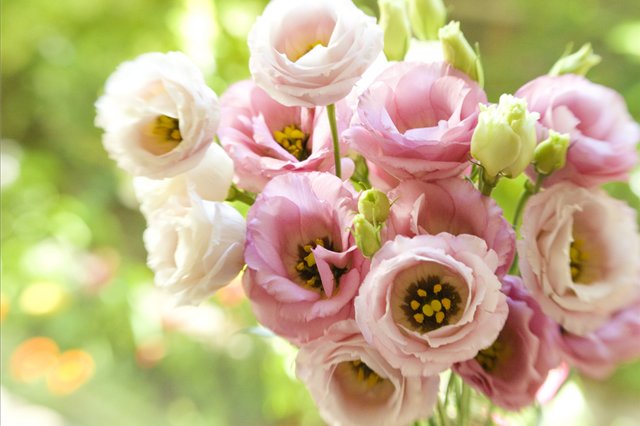
Diseases and pests
This plant is quite often exposed to diseases and pests, especially with insufficient lighting and top dressing.
Of the diseases of eustoma, they are prone to the development of gray rot, fusarium, false powdery mildew, root rot, late blight and tobacco mosaic virus. As mentioned above, seedlings often die from blackleg infestation.
Most of these diseases are fungal, and it will help to prevent them. regular prophylaxis all summer every 2-3 weeks with phytosporin or foundationazole. They will also help cure those diseases that, in principle, can be treated after removing the damaged parts of the plant.
Of the pests, you can find mealy mites, thrips, aphids, whiteflies, slugs, miners and mushroom mosquitoes on Lisianthus. They are driven out with systemic insecticides or acaricides, repeating the treatment after 4 to 6 days.
Especially carefully inspect the plant for diseases and pests before taking it home in the fall so as not to infect indoor flowers.
